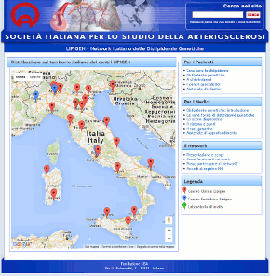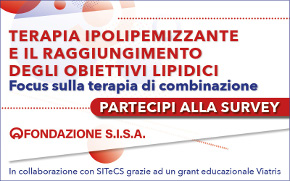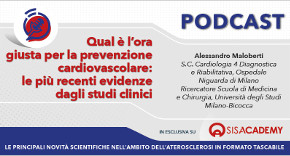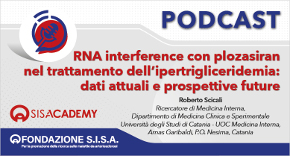 Rivista in lingua italiana
Rivista in lingua italiana
riservata ai Soci SISA
Ultimo numero:
Anno 16 • N.1/2025
SISANews
Utilità della clinica nella stima del rischio cardiovascolare
Per definizione il 20% dei pazienti ad alto rischio avrà un evento cardiovascolare nei 10 anni. Il restante 80%, no. Quando si passa dall'epidemiologia alla clinica quotidiana, diventa essenziale stimare chi avrà un evento e chi no, in modo da impostare un trattamento adeguato all'effettivo rischio individuale. I dati su cui si basa questa analisi provengono da un registro internazionale (International Reduction of Atherothrombosis for continued Health Registry - REACH) che comprende pazienti con varie manifestazioni di aterosclerosi che vanno da adulti asintomatici con solo fattori di rischio a pazienti con aterosclerosi stabile di varia entità. Lo scopo del registro è proprio quello di cercare di ottenere una stima della probabilità di eventi cardiovascolari applicabile al singolo individuo. Sono stati finora arruolati 68.236 pazienti e di questi 45.227, provenienti da 3.647 centri di 29 paesi sono stati inclusi in questo studio della durata di 4 anni. Nei 4 anni si sono verificati 5.481 eventi, il rischio più basso (7%) è stato osservato nei pazienti non diabetici con solo fattori di rischio, ma senza precedenti vascolari ed il più alto (25%) nei pazienti con malattia polivascolare e precedenti eventi ischemici. La conclusione è che tra i pazienti ad alto rischio alcune caratteristiche come la storia clinica e la valutazione del danno vascolare esistente possono aiutare a discriminare quei pazienti che più facilmente andranno incontro a nuovi eventi cardiovascolari e per i quali deve essere impostata una terapia più aggressiva per il controllo dei fattori di rischio.
![]()
Comparative determinants of 4-year cardiovascular event rates in stable outpatients at risk of or with atherothrombosis
Bhatt DL, Eagle KA, Ohman EM, Hirsch AT, Goto S, Mahoney EM, Wilson PW, Alberts MJ, D'Agostino R, Liau CS, Mas JL, Röther J, Smith SC Jr, Salette G, Contant CF, Massaro JM, Steg PG; REACH Registry Investigators.
JAMA 2010;304:1350-57
CONTEXT: Clinicians and trialists have difficulty with identifying which patients are highest risk for cardiovascular events. Prior ischemic events, polyvascular disease, and diabetes mellitus have all been identified as predictors of ischemic events, but their comparative contributions to future risk remain unclear.
OBJECTIVE: To categorize the risk of cardiovascular events in stable outpatients with various initial manifestations of atherothrombosis using simple clinical descriptors.
DESIGN, SETTING, AND PATIENTS: Outpatients with coronary artery disease, cerebrovascular disease, or peripheral arterial disease or with multiple risk factors for atherothrombosis were enrolled in the global Reduction of Atherothrombosis for Continued Health (REACH) Registry and were followed up for as long as 4 years. Patients from 3647 centers in 29 countries were enrolled between 2003 and 2004 and followed up until 2008. Final database lock was in April 2009.
MAIN OUTCOME MEASURES: Rates of cardiovascular death, myocardial infarction, and stroke.
RESULTS: A total of 45,227 patients with baseline data were included in this 4-year analysis. During the follow-up period, a total of 5481 patients experienced at least 1 event, including 2315 with cardiovascular death, 1228 with myocardial infarction, 1898 with stroke, and 40 with both a myocardial infarction and stroke on the same day. Among patients with atherothrombosis, those with a prior history of ischemic events at baseline (n = 21,890) had the highest rate of subsequent ischemic events (18.3%; 95% confidence interval [CI], 17.4%-19.1%); patients with stable coronary, cerebrovascular, or peripheral artery disease (n = 15,264) had a lower risk (12.2%; 95% CI, 11.4%-12.9%); and patients without established atherothrombosis but with risk factors only (n = 8073) had the lowest risk (9.1%; 95% CI, 8.3%-9.9%) (P < .001 for all comparisons). In addition, in multivariable modeling, the presence of diabetes (hazard ratio [HR], 1.44; 95% CI, 1.36-1.53; P < .001), an ischemic event in the previous year (HR, 1.71; 95% CI, 1.57-1.85; P < .001), and polyvascular disease (HR, 1.99; 95% CI, 1.78-2.24; P < .001) each were associated with a significantly higher risk of the primary end point.
CONCLUSION: Clinical descriptors can assist clinicians in identifying high-risk patients within the broad range of risk for outpatients with atherothrombosis.

Area Soci
Eventi
39° Congresso Nazionale
 39° Congresso Nazionale
39° Congresso NazionaleRoma, 23-25 novembre 2025
Save the date




 Spring Meeting Gruppi Giovani SID, SIGG, SIIA, SIMI, SIPREC, SISA
Spring Meeting Gruppi Giovani SID, SIGG, SIIA, SIMI, SIPREC, SISARimini, 6-8 aprile 2025
[continua a leggere]
 SISA LIPID ACADEMY - Corso avanzato di lipidologia clinica
SISA LIPID ACADEMY - Corso avanzato di lipidologia clinicaModena, 4-5 Luglio 2024
[continua a leggere]Giornale Italiano Arteriosclerosi
HoFH today
 Rivista Italiana della
Rivista Italiana della
Ipercolesterolemia
Familiare Omozigote
Anno 6 • N.1/2024
Rivista NMCD
Diateca
[continua a leggere]
[continua a leggere]
Newsletter
il vostro indirizzo di posta elettronica
Progetto LIPIGEN

Nuovo sito dedicato al Progetto LIPIGEN
Progetto LIPIGEN - Vecchio portale
E' necessario essere loggati come utente
Lipigen per poter accedere alla pagina
PROject Statin Intolerance SISA
PROSISA – PROject Statin Intolerance SISA
E' necessario essere loggati come utente
PROSISA per poter accedere alla pagina
GILA - Lipoprotein Aferesi
Gruppo Interdisciplinare Lipoprotein Aferesi
(Accesso Gruppo GILA-Lipoprotein Aferesi)
E' necessario essere loggati come utente del Gruppo GILA per poter accedere
Gruppo Interdisciplinare Lipoprotein Aferesi
(Documentazione ad accesso libero)
Pagina informativa per medici e pazienti










